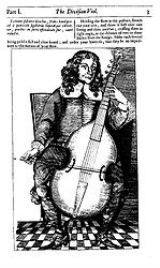
Division viol
Encyclopedia

Viol
The viol is any one of a family of bowed, fretted and stringed musical instruments developed in the mid-late 15th century and used primarily in the Renaissance and Baroque periods. The family is related to and descends primarily from the Renaissance vihuela, a plucked instrument that preceded the...
, which was originally popular in the mid-17th century, but is currently experiencing a renaissance of its own due to the movement for historically informed performance
Historically informed performance
Historically informed performance is an approach in the performance of music and theater. Within this approach, the performance adheres to state-of-the-art knowledge of the aesthetic criteria of the period in which the music or theatre work was conceived...
. John Playford
John Playford
John Playford was a London bookseller, publisher, minor composer, and member of the Stationers' Company, who published books on music theory, instruction books for several instruments, and psalters with tunes for singing in churches...
mentions the division viol in his A Brief Introduction of 1667, describing it as smaller than a consort
Consort of instruments
A consort of instruments was a phrase used in England during the sixteenth and seventeenth centuries to indicate an instrumental ensemble. These could be of the same or a variety of instruments. Consort music enjoyed considerable popularity at court and in households of the wealthy in the...
bass viol, but larger than a lyra viol
Lyra viol
The lyra viol is a small bass viol, used primarily in England in the seventeenth century.While the instrument itself differs little physically from the standard consort viol, there is a large and important repertoire which was developed specifically for the lyra viol...
.
As suggested by its name, (divisions
Division (music)
Division in music refers to a type of ornamentation or variation common in 16th and 17th century music in which each note of a melodic line is "divided" into several shorter, faster-moving notes, often by a rhythmic repetition of a simple musical device such as the trill, turn or cambiata on each...
were a type of variations), the division viol is intended for highly ornamented
Ornament (music)
In music, ornaments or embellishments are musical flourishes that are not necessary to carry the overall line of the melody , but serve instead to decorate or "ornament" that line. Many ornaments are performed as "fast notes" around a central note...
music, and for improvisations
Musical improvisation
Musical improvisation is the creative activity of immediate musical composition, which combines performance with communication of emotions and instrumental technique as well as spontaneous response to other musicians...
. The division viol also had a very large range
Range (music)
In music, the range of a musical instrument is the distance from the lowest to the highest pitch it can play. For a singing voice, the equivalent is vocal range...
with the tuning
Musical tuning
In music, there are two common meanings for tuning:* Tuning practice, the act of tuning an instrument or voice.* Tuning systems, the various systems of pitches used to tune an instrument, and their theoretical bases.-Tuning practice:...
D–G–c–e–a–d', resulting in the ability of skilled players to play divisions on any part in a polyphonic vocal piece.
The division viol may be historically connected with the viola bastarda
Viola bastarda
Viola bastarda refers to a highly virtuosic style of composition or extemporaneous performance, as well as to the altered viols created to maximize players' ability to play in this style. In the viola bastarda style, a polyphonic composition is reduced to a single line, while maintaining the same...
, and came into being in the mid-17th century in England
England
England is a country that is part of the United Kingdom. It shares land borders with Scotland to the north and Wales to the west; the Irish Sea is to the north west, the Celtic Sea to the south west, with the North Sea to the east and the English Channel to the south separating it from continental...
. Music for the division viol was mainly linear, although there were occasionally lyra-like passages, and music for it was written on a staff, rather than in tablature
Tablature
Tablature is a form of musical notation indicating instrument fingering rather than musical pitches....
like the lyra viol's music.
Christopher Simpson
Christopher Simpson
Christopher Simpson was an English musician and composer, particularly associated with music for the viola da gamba.-Life:Simpson was born between 1602 and 1606, probably at Egton, Yorkshire...
, a prominent viol player, wrote a treatise on how to play the division viol, aptly titled The Division-viol, or The Art of Playing ex tempore to a Ground (1665), and also The Division-Violist (1659). Both of these are frequently used as references by those interested in historically informed performance on the viol.
Although the division viol is a specialized instrument for playing divisions, divisions of the same period that this instrument flourished were almost as likely to be played on a consort bass or a lyra viol, and instruments constructed as division viols were certainly used in consorts when called upon.
External links
- The Division Viol (Simpson)
- A Brief Introduction (Playford)

